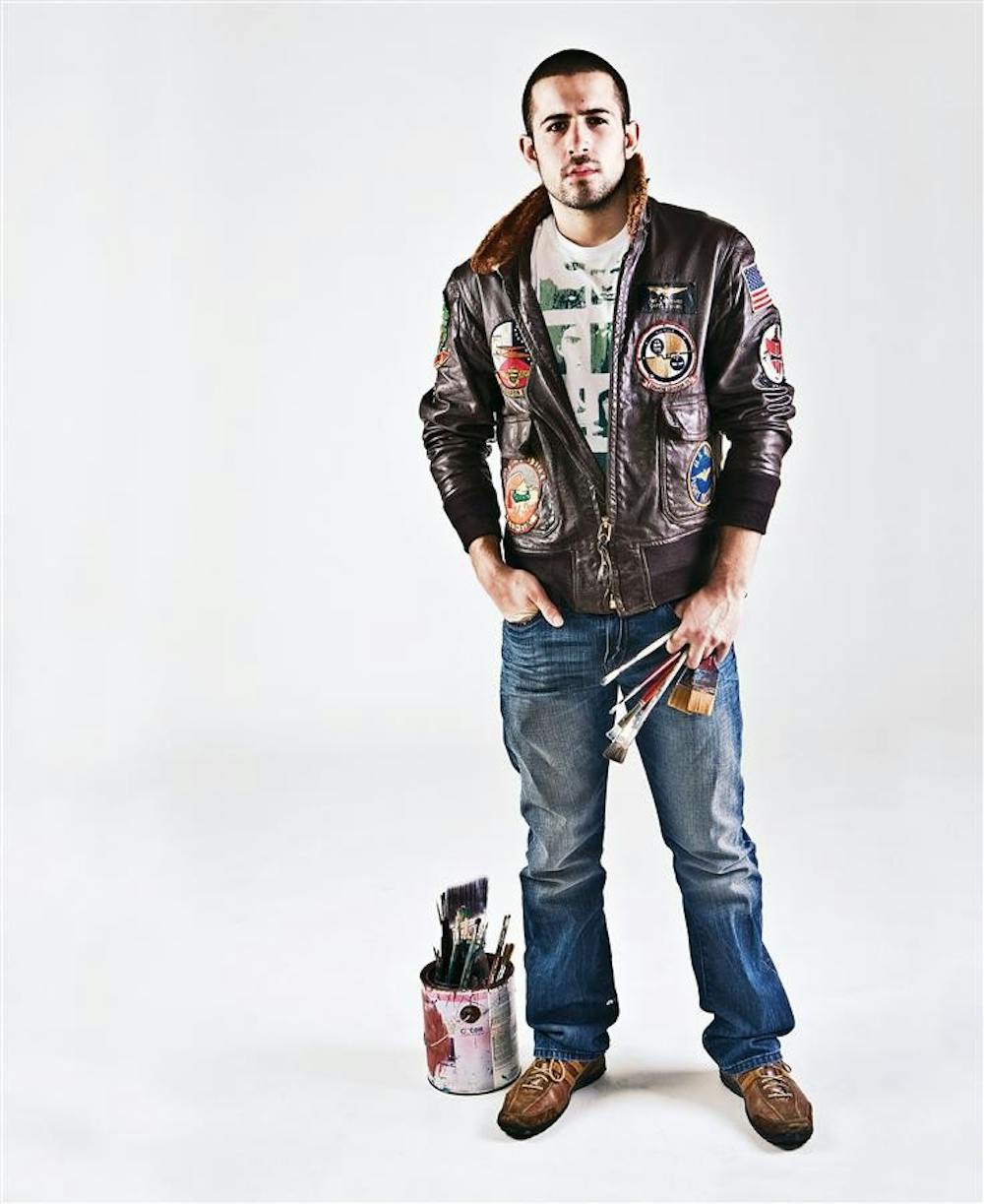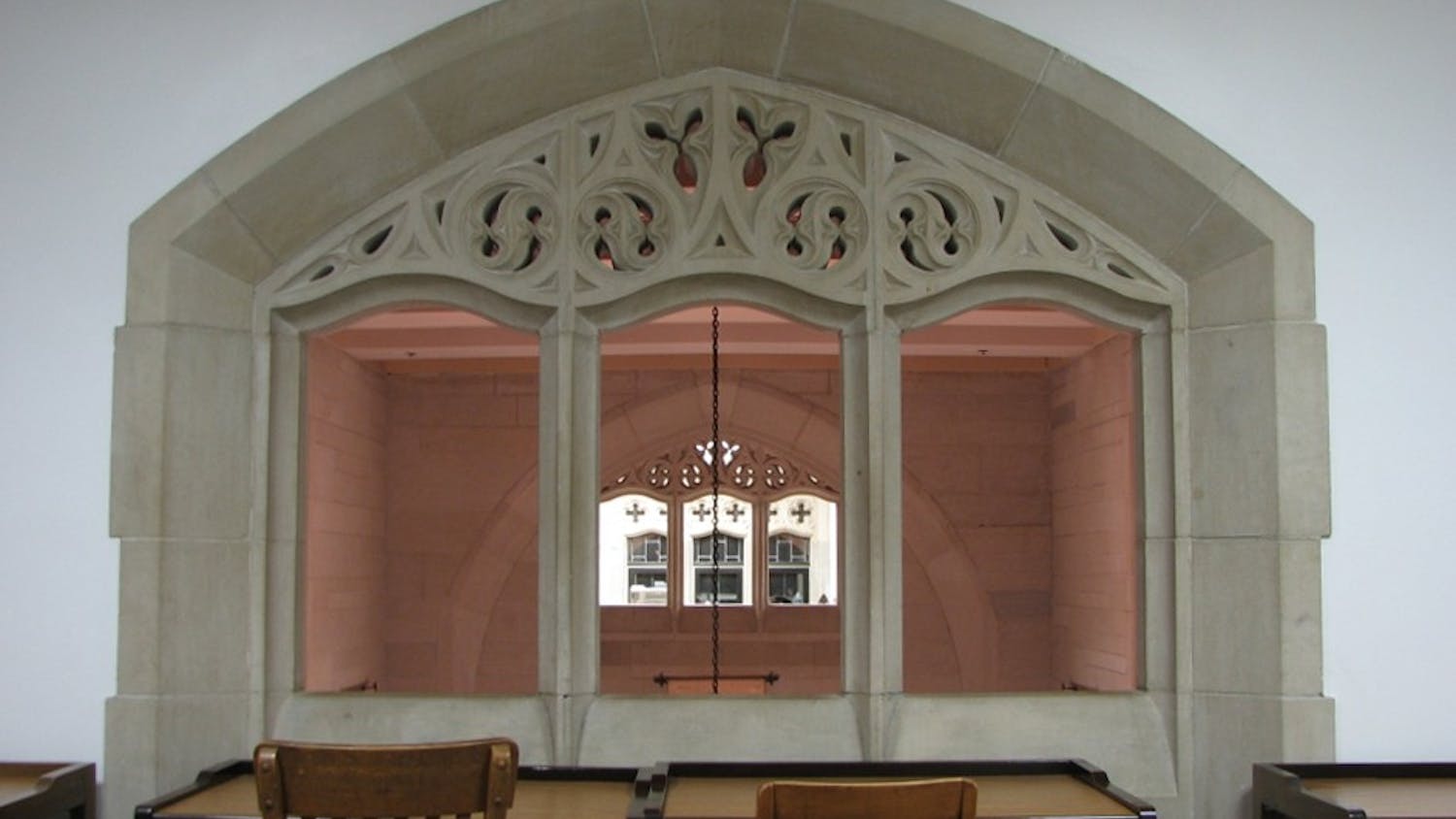IN HIS EMPTY ART STUDIO on Woodlawn Avenue, senior Troy Mottard is repainting the walls a fresh hue of white. His jeans and navy sweatshirt, splattered with bits of paint, are characteristic of the rest of his wardrobe. He takes a break from stirring paint and fiddles with the black iPod sitting nearby. It, too, is splashed with a drop of red.
A fine arts student in oil painting, Mottard believes creativity isn’t something you can touch, but something you can feel. “I think of creativity as a physical place that keeps changing,” he says. “It’s an opinion, it’s how you feel a certain way, and it keeps changing.”
To Mottard, art isn’t just interesting. It’s a part of who he is, as essential as sleep or breathing. Strip him of his canvas, paints, and brushes, and he might burst, spewing creative energy out around him. “When I’m making something, I get a sense of euphoria, and if I stop, I don’t have that feeling anymore,” he says. “It’s not exactly an addiction, but it is a craving.”
Artists everywhere talk of the allure of their craft – this need to be creative – but what is creativity? Psychologists say it’s the generation of ideas, insights, or problem solutions that are new or meant to be useful, or as an elusive quality waiting to be tapped and unleashed, but those definitions only go so far. How is creativity generated? Is it innate or fostered by time, environment, and experience? And is it something we’re all capable of?
Finding answers to those questions is, in a sense, IU professor Jonathan Plucker’s raison d’etre. Plucker, a professor of educational psychology and cognitive sciences, specializes in creativity research. He says the word “creativity” has been wrongly defined in the past. “Some say it’s only originality, but different doesn’t always mean creative,” he says. “It’s a trap we’ve gotten into.”
Plucker defines creativity as originality and usefulness, but only within a specific social context, since these terms are difficult to define. “It’s very relative, very situational,” he says. He says he believes that though some people are more creative than others, everyone has the potential. Unfortunately, he says most people don’t even begin to tap into their creativity. “For all intents and purposes, the nature versus nurturer argument is irrelevant because we can all be more creative,” Plucker says.
IU graduate David Schneider hasn’t had any trouble tapping into his creative side thus far. A classical music composer, he’s spent the last 10 years devoted to his music. When he began working on the piece that would complete his master’s degree in composition from the Jacobs School of Music, he was sure of two things: First, it would not be written for an orchestra, and second, it would be unusual.
He centered it on two Shakespearian sonnets that drew him in: the well-known Sonnet 18 (“Shall I Compare Thee to a Summer’s Day”) and the lesser-known Sonnet 65, which begins “Since brass, nor stone, nor earth, nor boundless sea.” To Schneider, the poems shared a common thread. Both, he says, comment on the transitory nature of life, and the ability of art not only to preserve, but also to persevere when everything else is lost.
The end result is something Schneider says he feels particular affection for. Though time and effort are surely a factor — from start to finish, it took him two years to complete — it’s more than that.
When he first tried his hand at composing, he found it was mysterious, romantic, even, and hearing a finished composition such as this one reacquaints him with those early moments of magic. But more importantly, perhaps, it’s another reminder of his long-realized desire to create. “There was no particular moment that I decided I would be a composer,” he says. “I just always knew that I would do something creative.”
One way to unhinge creative abilities is to silence the inner critic, says Ken Weitzman, a professional playwright and visiting professor in IU’s playwriting program. Weitzman describes creativity as the “reordering of the status quo.” Though he says everyone has the ability to be creative, he also believes it must be nurtured.
He teaches his undergraduate students this by encouraging them to not only develop their voices, but to feel comfortable with what they have to say.
During a recent class, he gave an exercise to help free the mind’s natural impulses. He handed out two note cards to his students. On one card, they were told to write a cliche, and on the other, something specific. After passing the cards around, Weitzman told them to use the phrases as the opening and closing lines of a monologue. His only stipulation was that they write continuously for 10 minutes without lifting their pens from the paper.
He didn’t care how vulgar, absurd, or silly their writing became, just that they not stop. “You have to turn the inner sensor off,” he says. “You can judge everything you write to the point where it never makes it on the page.”
Emma Vaughn, who graduated from IU in December with a degree in psychology, wrote her honors thesis on creativity, paying particular attention to mood. Psychologists say mood is perhaps the most widely studied and least disputed predictor of creativity. Though many studies propose that positive moods do improve creative problem solving, there are few theories explaining just how it happens.
Perhaps one explanation is that in some cases, it is a negative mood that actually increases creativity. Psychologist Carsten De Dreu, of the University of Amsterdam, published in 2007 an oft-cited article theorizing that creativity is the function of both mental flexibility and persistence. Through various studies, he found that while positive moods led to higher levels of mental flexibility, tasks that required problem solving within a narrower framework were better facilitated by negative moods.
Vaughn says she wanted to explore the correlation between negative mood and creativity after studying artists such as English novelist Virginia Woolf, who suffered breakdowns and recurrent depressing periods while her creative and literary abilities remained in tact. “With this evidence in mind,” she says, “it makes it easy to question the generally accepted conclusion that positive mood states produce more creativity versus negative mood states.”
Vaughn conducted two studies using introductory psychology students. At the start of the experiment, each person was told they would be participating in a linguistics task. They were then shown a randomly assigned film clip, which induced either a happy, sad, or neutral feeling. Vaughn was interested in exploring the things that came to people’s minds spontaneously, so participants were asked to list and rate modes of transportation as being commonplace (bus or car) or out of the ordinary (a magic carpet).
One of her primary goals, she says, was to find whether happy participants would be more flexible information processors versus sad or neutral participants.
What she found was that sad participants generated more creative responses overall. Though they demonstrated less mental flexibility, they showed greater numbers of ideas or insights. Vaughn says the negative mood participants tended to dig deeper within fewer categories whereas the positive mood participants had a broader range of responses. Similar to De Dreu’s findings, she concluded that negative moods could facilitate more creativity, but only within a narrower focus.
Junior Keane Rowley, president of the IU break dance team, says his mood definitely affects how he dances. Having never danced before college, it was during his freshman year that the sounds of music drew him to the crowd gawking at the group of students spinning on their heads and hands. “When I’m mad, I dance tough. When I’m sad, I dance sad. When I’m happy, I dance silly,” Rowley says.
He describes creativity as taking everything you’ve learned and experienced and changing the format. “Every minute is a new minute,” Rowley says. “Every day is a new day. It’s all about trying new things, taking risks.”
WHILE VAUGHN ADMITS that more evidence is needed to support her findings, photographer Sara Baldwin, a junior majoring in journalism, would say she’s right.
Sitting in Soma coffee shop, Baldwin, dressed in tight black jeans and a dark purple shirt, recounted her experience studying abroad in Paris this past summer through the School of Fine Arts.
Upon arrival, she says the first thing she noticed was the number of bicycles in the city. Thinking that the bike culture in Paris would be similar to that of Bloomington’s – trendy, she says, with cycles reflective of owners – she decided to visit various Parisian neighborhoods and photograph people with their bikes in the hopes that the personality of each would change from place to place.
What she found, though, was that the bikes didn’t say much about the areas at all. They weren’t telling or different, but rather “mode de vie,” a part of life and an essential form of transportation for many Parisians. Because of this, she had to turn her project, which every student had to complete by the end of the program, into a broader expression of transient life and culture in Paris.
The project, “Les Velos de Paris,” or “The Bikes of Paris,” was successful in the end, but not without frustration and disappointment along the way. Though Baldwin says she loved being in Paris, she felt unhappy most of the time. “I was really lonely and frustrated most of the time,” she says, “but because of that, I worked really hard.”
She says her negative mood drove her to devote all of her attention to the bike project. “The whole time that I was angry and lonely, that’s when I got the best work done because I was trying to prove everyone wrong.”
Baldwin, who self-describes as being “obsessed” with photography (she owns 12 cameras), thinks of creativity as the manifestation of ideas that must be made into reality. And as she advances in her skills, she says she finds more opportunities to get creative with her photos by playing around with angles or lighting. She likes that photography changes the reality – and, as a result, the memory – of a situation. “I like the idea that photography is a mirror of reality. The lens distorts it, so it is different, but also exactly how you first saw it.”
Professor Plucker says he believes there should be more talk about creativity, especially in today’s global world. “We need to put our money where our mouth is, and focus on innovative problem solving, ” he says. He worries that if we don’t, countries that do put attention on creativity, such as China and Taiwan, will eventually dominate. This, he says, is one reason why he keeps researching this area with such a passion. “Creativity really is the study of human potential,” he says. “Are we doing enough? Are we helping college students be creative? That should be priority number one.”






